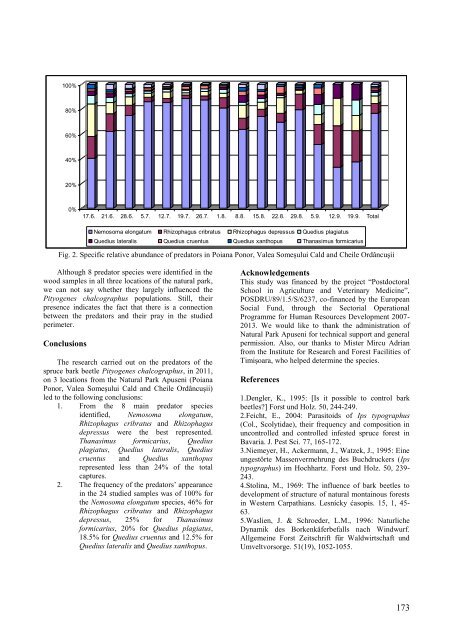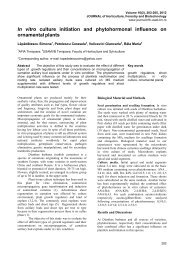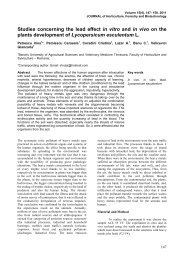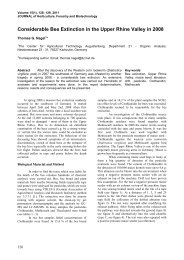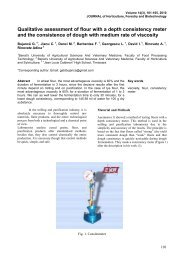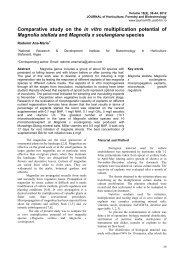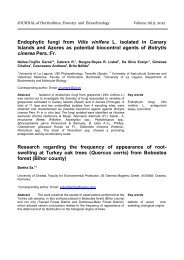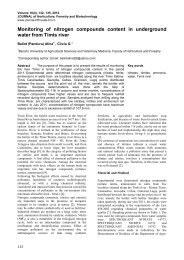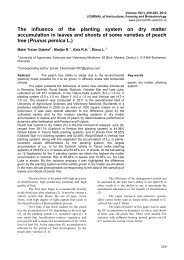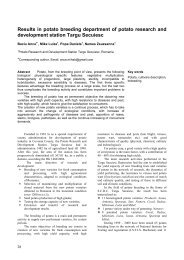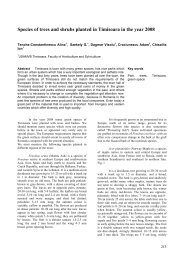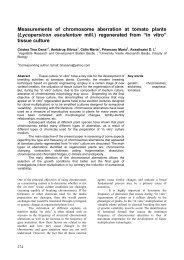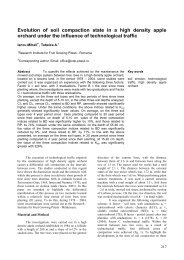Parasitoids of Ips typographus (Coleoptera: Scolytidae) - Journal of ...
Parasitoids of Ips typographus (Coleoptera: Scolytidae) - Journal of ...
Parasitoids of Ips typographus (Coleoptera: Scolytidae) - Journal of ...
Create successful ePaper yourself
Turn your PDF publications into a flip-book with our unique Google optimized e-Paper software.
100%<br />
80%<br />
60%<br />
40%<br />
20%<br />
0%<br />
17.6. 21.6. 28.6. 5.7. 12.7. 19.7. 26.7. 1.8. 8.8. 15.8. 22.8. 29.8. 5.9. 12.9. 19.9. Total<br />
Nemosoma elongatum Rhizophagus cribratus Rhizophagus depressus Quedius plagiatus<br />
Quedius lateralis Quedius cruentus Quedius xanthopus Thanasimus formicarius<br />
Fig. 2. Specific relative abundance <strong>of</strong> predators in Poiana Ponor, Valea Someşului Cald and Cheile Ordâncuşii<br />
Although 8 predator species were identified in the<br />
wood samples in all three locations <strong>of</strong> the natural park,<br />
we can not say whether they largely influenced the<br />
Pityogenes chalcographus populations. Still, their<br />
presence indicates the fact that there is a connection<br />
between the predators and their pray in the studied<br />
perimeter.<br />
Conclusions<br />
The research carried out on the predators <strong>of</strong> the<br />
spruce bark beetle Pityogenes chalcographus, in 2011,<br />
on 3 locations from the Natural Park Apuseni (Poiana<br />
Ponor, Valea Someşului Cald and Cheile Ordâncuşii)<br />
led to the following conclusions:<br />
1. From the 8 main predator species<br />
identified, Nemosoma elongatum,<br />
Rhizophagus cribratus and Rhizophagus<br />
depressus were the best represented.<br />
Thanasimus formicarius, Quedius<br />
plagiatus, Quedius lateralis, Quedius<br />
cruentus and Quedius xanthopus<br />
represented less than 24% <strong>of</strong> the total<br />
captures.<br />
2. The frequency <strong>of</strong> the predators’ appearance<br />
in the 24 studied samples was <strong>of</strong> 100% for<br />
the Nemosoma elongatum species, 46% for<br />
Rhizophagus cribratus and Rhizophagus<br />
depressus, 25% for Thanasimus<br />
formicarius, 20% for Quedius plagiatus,<br />
18.5% for Quedius cruentus and 12.5% for<br />
Quedius lateralis and Quedius xanthopus.<br />
Acknowledgements<br />
This study was financed by the project “Postdoctoral<br />
School in Agriculture and Veterinary Medicine”,<br />
POSDRU/89/1.5/S/6237, co-financed by the European<br />
Social Fund, through the Sectorial Operational<br />
Programme for Human Resources Development 2007-<br />
2013. We would like to thank the administration <strong>of</strong><br />
Natural Park Apuseni for technical support and general<br />
permission. Also, our thanks to Mister Mircu Adrian<br />
from the Institute for Research and Forest Facilities <strong>of</strong><br />
Timişoara, who helped determine the species.<br />
References<br />
1.Dengler, K., 1995: [Is it possible to control bark<br />
beetles?] Forst und Holz. 50, 244-249.<br />
2.Feicht, E., 2004: <strong>Parasitoids</strong> <strong>of</strong> <strong>Ips</strong> <strong>typographus</strong><br />
(Col., <strong>Scolytidae</strong>), their frequency and composition in<br />
uncontrolled and controlled infested spruce forest in<br />
Bavaria. J. Pest Sci. 77, 165-172.<br />
3.Niemeyer, H., Ackermann, J., Watzek, J., 1995: Eine<br />
ungestörte Massenvermehrung des Buchdruckers (<strong>Ips</strong><br />
<strong>typographus</strong>) im Hochhartz. Forst und Holz. 50, 239-<br />
243.<br />
4.Stolina, M., 1969: The influence <strong>of</strong> bark beetles to<br />
development <strong>of</strong> structure <strong>of</strong> natural montainous forests<br />
in Western Carpathians. Lesnícky ćasopis. 15, 1, 45-<br />
63.<br />
5.Waslien, J. & Schroeder, L.M., 1996: Naturliche<br />
Dynamik des Borkenkäferbefalls nach Windwurf.<br />
Allgemeine Forst Zeitschrift für Waldwirtschaft und<br />
Umveltvorsorge. 51(19), 1052-1055.<br />
173


